The Malvaceae family
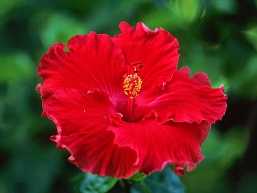
photo by Violet Krochmalny
Most all Floridians are familiar with the large tropical evergreen Hibiscus, Rosa sinenis. It is bright and sunny and totally tropical looking with gorgeous flowers that bloom nearly year round. Vero Beach, in particular, is called “Hibiscus City” even though Hibiscus really should not be able to grow well here. As that Latin name suggests, Hibiscus are native to Asia and prefer rich, loamy soil, just the right mix of sun and shade and regular water amounts. Their blossoms come in every color of the rainbow except blue, black, and green. Flowers are edible and taste like iceberg lettuce, making a very colorful addition to your salad!
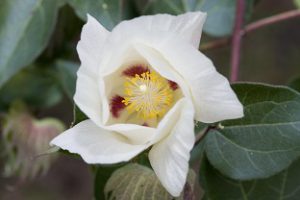
The Relatives
Hibiscus is a member of the Mallow family, or Malvaceae, which includes many important plants along with our town’s beautiful nick-namesake. Some of these include fiber crops, medicinal plants, foods, sweeteners, tools and a few invasive species. Important Malvaceae crops include:
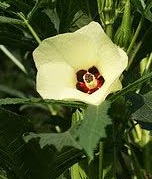
- Cotton, Gossypium spp., native to Mexico
- Okra, Abelmoschus esculentus, disputed origins
- Roselle, Hibiscus sabdarifa, West Africa.
- Cacao (aka chocolate), Theobroma cacao, deep tropical Central American native.
- Marsh mallow, Althaea officinalis, native to Europe, Western Asia, and North Africa.
- Swizzlestick tree, Quararabea turbinata, Caribbean native.
- Caesar weed, Urena lobata, brought to Florida as a crop plant for cordage, is now listed as an invasive weed. No mention of its origins.
For Beauty
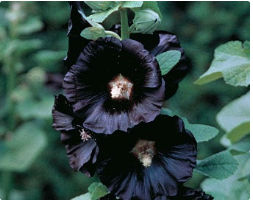
If any of you are from the northern states, you may think these large, brash Hibiscus flowers look almost like something familiar from Grandma’s garden. And they do! A tall, slender relative of Hibiscus, the biennial Hollyhock, Alcea spp., is native to Asia and Europe. The hybrids come in a wide range of bloom colors including a black flowered variety. These tall garden flowers are for the back of the flower bed where they can reach up to ten feet tall. Being a biennial, hollyhock will grow green and tall the first summer and will not flower till the following summer. In the fall, the whole plant dies back to the ground to await Spring. There is an American native “hollyhock”, the streambank wild hollyhock, Iliamna rivularis, which is native to Northern North America from Canada down into Colorado. Unfortunately, other than extreme northern Florida, only the Vietnamese Hollyhock can be grown this far south, and that takes some tricky timing and very hot water.
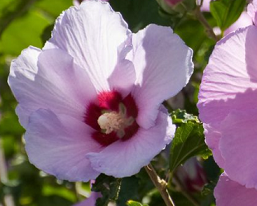
The Rose of Sharon, Hibiscus syriacus, shrub is another Malvaceae family member. It is a perennial shrub but is not evergreen. It loses its leaves in winter. These pretty bushes come with varied blossom sizes and colors and can sometimes be grafted to get multiple different colored flowers on one plant.
Another Mallow is the Swamp mallow, or Rose mallow, Hibiscus moscheutos, which usually has red, pink or white blooms. As it’s common name suggests, swamp mallow is native to wetlands and riverbanks from Texas, thru the East Coast up into Ontario, Canada. I’ve seen a pink one growing just off Interstate-95 near Daytona in early June. They like it wet! Another Swamp mallow, the Scarlet Rose mallow, Hibiscus coccineus, is striking with large palmate leaves and huge red flowers.
For Usefulness
The Marsh Mallow, Althaea officinalis, may sound familiar as the popular S’mores ingredient, marshmallows, which were once made from the roots of this plant. It is native to Europe, Northern Africa and Western Asia and was probably first brought to the United States during colonial times for its medicinal properties and use in sweets.
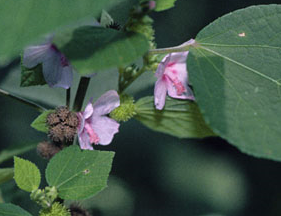
Caesar weed, Urena lobata, originally a cordage crop (Congo jute), has now been classified as an invasive weed. The seeds are like burdock (not related) and will stick to everything: clothing, hair, horses mane and tails and the dog’s ears. Thus its more common name, Burr weed. it’s flowers are always a pink-violet color, small, and very pretty. But don’t be fooled. In most places it is considered an annual weed but it is perennial in Florida, persisting all year long. Once you’ve tangled with it you will recognize it always and pull them up as soon as their leaves reveal themselves. Seeds persist in the soil for years, hence its invasive status.

Roselle, Hibiscus sabdarifa, sometimes called Jamaican Sorrel and Florida Cranberry, is a very pretty annual hibiscus. After the flower blossoms and falls off, the persistent calyx swells to look and taste like a very tart berry. It is the source of the Caribbean Sorrel punch, Hibiscus tea, and many commercial herbal teas such as “Raspberry Zinger”. There are even sweetened, dried roselle sold as dried fruit which are VERY good for snacking. It is high in vitamin C and makes a very refreshing bright red summertime drink with several medicinal qualities. Start seeds in April as the plant matures and is done producing by November. To know when to harvest, try to snap off the swollen calyx by bending sharply to one side. If it breaks off easily, it is ready to pick.
And I am not going to even start writing the praises of Cacao, from which we get Chocolate. This is a cold sensitive tropical small tree native to Central America. There is a fruit juice made from the edible, fleshy seed covering that is extracted in the chocolate making process which is quite good. For more on this subject, please see the University of Florida’s publication #HS1057 “Cacao (Chocolate Bean) Growing in the Florida Home Landscape“.
Learn More
The Malvaceae family is truly a diverse and fascinating family of plants. From this one family, we can make comfortable clothing, gumbo, medicine, candy, vitamin rich punch, and rope. It is worth knowing more about them as they are present all over the world with the exception of the tundra. To learn more of this varied plant family, please visit the numerous University of Florida EDIS publications on Mallows.
 1
1
